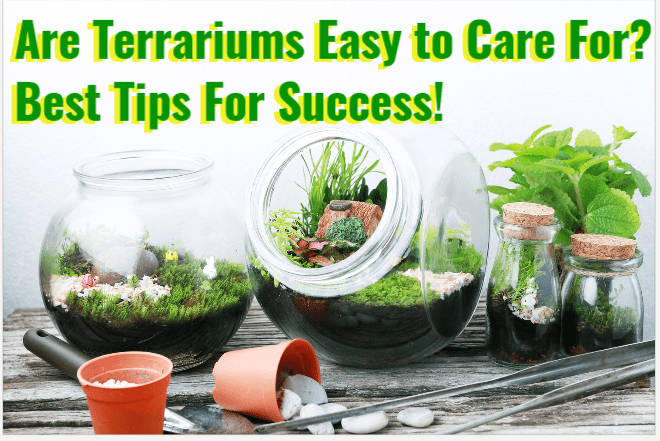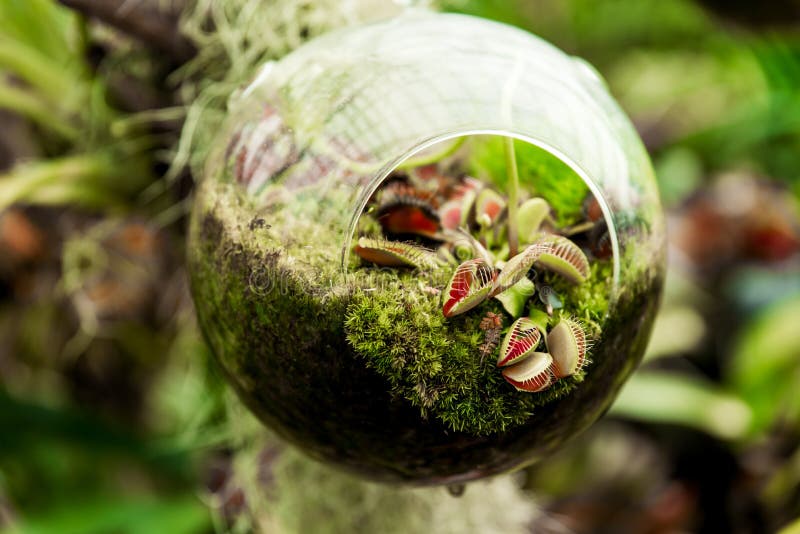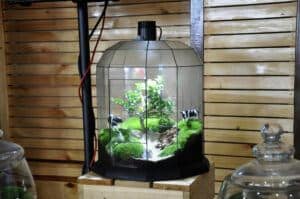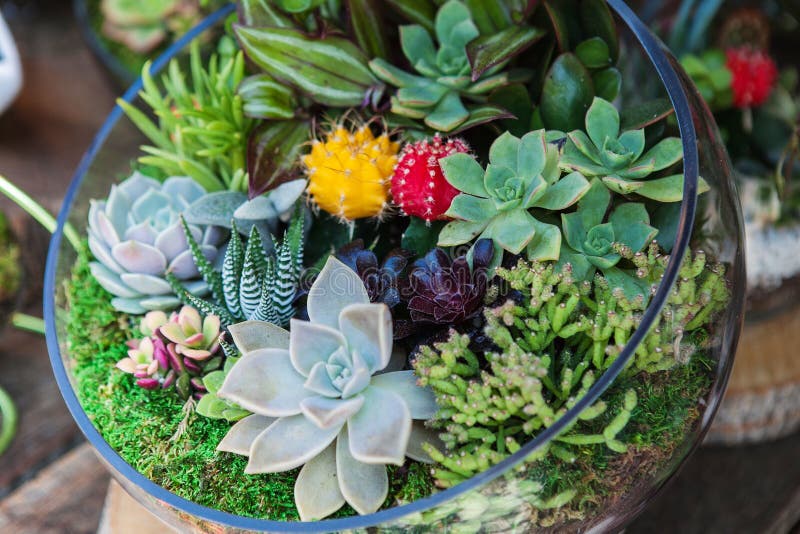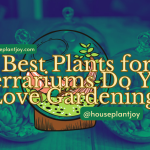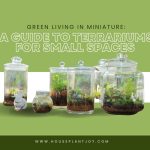HousePlantJoy is supported by our audience. When you purchase through one of our links, we may earn a small affiliate commission. As an Amazon Associate I earn from qualifying purchases. Your cost is not affected.
==================
CARE TIPS FOR OPEN STYLE TERRARIUMS
Terrariums are a popular gardening concept that brings miniature plant worlds into the house. Popular yes. But are terrariums easy to care for? Today’s busy families need plants that don’t demand hours of care each week.
The goal is to develop a self-sustaining ecosystem in a vessel that provides food for the plants that dwell inside. They do, however, need periodic maintenance to maintain a healthy atmosphere for your plants. So many of you will be curious are terrariums easy to care for or not. In this article, we will discuss primary terrarium care and the mistakes that you should avoid. Let’s get started!
What is a Terrarium?
For many plants, terrariums provide a tiny, confined habitat. Consider it a miniature greenhouse. Terrarium gardens usually reside in translucent containers, such as plastic or glass. They’re sealed-container indoor gardens. The terrarium’s plants and soil emit water vapor, effectively recycling water. The moisture is then gathered on the vessel’s walls and drips into the earth. Terrariums are self-sufficient, which means they require little upkeep if kept sealed.
Types of Terrarium
Closed Terrarium
The closed terrarium is a sealed container that functions as a complete environment. Condensation accumulates on the walls of a closed terrarium, supplying water to the plants. Terrariums that keep closed are self-contained. Because the glass container is clear, light may enter through, and photosynthesis may occur. However, never set them in full sunlight since the glass container will heat up, and the plants may burn.
Open Terrarium
With no top to cover all of the plants in the glass container, we call it an open terrarium. In some, the plants may be partially protruding from the pots. Open terrariums, unlike closed terrariums, enjoy drier environments and do not need to be kept moist in the same way. In fact, they lack a regular water cycle because they are open to the elements. As a result, open terrariums need water once a month, or if the soil starts to dry out and the leaves start to fall off.
How to Make a Terrarium
- To house your garden, choose a glass or plastic vessel. You might make one from a soda bottle, fish tank, fishbowl, or jar. Or, purchase one designed for terrarium use.
- Create your drainage layer. Put a layer of sheet moss in the bottom. Alternatively, you might use a 2-inch layer of stones in the bottom instead of moss.
- Add about 1/2 inch layer of activated charcoal on top of the stones. This help improve drainage and also controls odors.
- Now, add a layer of moss over the bottom layers. This ensures your potting soil does not mixed with the charcoal and stones in the bottom. It also adds a nice visual touch!
- Add sterile potting mix on top of the moss. This layer should be at least two inches deep. But keep the soil level low enough to allow the plants to fit in properly.
- Shake any excess soil off the plant roots and make sure the roots are not root-bound. If they are, gently separate them. You might even clip a small portion of the roots off, if necessary.
- Use your finger or a small spoon to make a hole large enough for the plant’s roots to rest in the dirt.
- Place the plants in the thin layer of soil and cover them with the second layer of dirt. Press down firmly; the new soil level should be roughly the same as the root ball’s original soil level.
- Mix up the plants, colors, and sizes to create a unique look.
- You might also add small figurines, shells, or another accent décor to create the desired look.
- Water the plants so they are just damp. Avoid soaking them.
- Clean off any dirt clinging to the sides of the container.
Are Terrariums Easy To Care For?
Terrarium plants are easy to care for since they grow slowly in a restricted environment yet produce healthy plants. Some essential tips require caring for terrariums. However, Pruning is a necessary part of keeping a terrarium healthy and appealing.
Maintenance of Your Terrarium
Every couple of weeks, your terrarium might need routine maintenance. Follow these easy steps.
- Feel the soil. If it’s dry, add water. Again, it should be moist but avoid soaking your plants. Keep in mind that enclosed terrariums retain water moisture much longer than your potted houseplants.
- If your terrarium is a closed style, check for condensation. At least once a month, take the top off and allow it to air out. Leave the top off until the water condensation disappears. NOTE: if you add too much water, you can also leave the top off to help it evaporate.
- Tend to your plants. Remove yellowing or damaged leaves. Prune plants if they need. If any have outgrown their terrarium home, you might choose to replace them with a smaller plant.
Mistakes to Avoid While Caring For a Terrarium
Avoid Too Much Light
The majority of plants that are good for terrariums don’t require a lot of light. Also, terrarium glass functions as a magnifier. As such, too much direct light will burn plants. Temperatures inside the Terrarium often rise quickly. This creates a rapid rise in both temperature and humidity.
Avoid Heat Source
The heat from a heater or heating outlet may soon destroy your plants. Most terrarium plants do poorly or perish when placed on or near a radiator or other heating element.
Don’t Overcrowd Your Terrarium
You want to enjoy individual plants and observe the other ornamental items inside the terrarium. Also, when crowded, plants tend to grow lanky and show signs of stress. Trim your terrarium plants when they get overgrown and have crowded the terrarium. You may also clip their roots to keep them from growing too large. It’s necessary to maintain them nice and clean. Remember, your terrarium plants might outgrow their home at some point. When that happens, simply give the larger plants a new home and add some smaller ones in their place.
Keep the Terrarium Clean
Clean the interior and outside of the glass of your terrarium as needed. Clean glass or plastic serves two purposes. First, the clean surface allows light to enter in as it should. In addition, a clean environment helps prevent fungus, disease, and pests from infiltrating your terrarium.
To clean glass or plastic, avoid any cleaning materials that might harm the plants. Use a moistened paper towel or cleaning cloth. Do not use glass cleaners, bleach, or glass cleaners. These may affect your plants and potentially kill them.
Don’t Overwater
It’s a fact. More plants die from overwatering than underwatering. In the event that you do, use a paper towel to absorb extra water. Then leave the cover off until it dries enough.
Overfertilization
The majority of terrarium plants do not require fertilization. You don’t want to feed terrarium plants since they will rapidly overrun their constrained habitat, therefore don’t provide them.
Wrong Plant
While practically anything may be grown in a terrarium, it’s vital to pick plants that will survive in the terrarium you’re making. Choose plants that thrive in a damp climate if you’re making a closed terrarium. Also, make sure to group plants that demand the same amount of light. Low-light plants are the most effective.
Check for Humidity
Because most houses have dry air, humidity isn’t usually an issue with open terrarium maintenance. Still, it may be if you live in a tropical climate or have a humidifier – or an extensive collection of plants. If that’s the case, make sure the container gets plenty of light and doesn’t overwater it.
How to Care For Open Terrarium
There’s no actual science behind maintaining an open terrarium. You can attempt to keep your plants fed and happy without the need to balance a little ecology delicately. However, there are critical things to consider while caring for an open terrarium.
Plants for open terrarium
It might be challenging to choose terrarium plants because many wonderful selections look excellent and survive in terrariums. Although an open terrarium may accommodate tiny, resilient houseplants, it is best suited for cacti and other succulents, which thrive in this miniature desert atmosphere. Houseplants, on the other hand, can frequently work just as well.
Sunlight
A terrarium requires sunlight. However, keep in mind that it is essentially a greenhouse. In direct sunshine, it’s pretty simple to sunburn your plants.
Just keep in mind where you’re placing your terrariums and what sort of light your plants require. While closed terrarium plants are nearly exclusively shade-loving, open terrarium plants are frequently the polar opposite. That means you can display these by the window!
Succulents like many hours of direct sunshine every day so set them on a ledge where they’ll catch some morning rays. Plants for the home come in a variety of shapes and sizes.
Pest and Diseases
Because they expose to the outside world, open terrariums are more prone to bugs, pests, and infestations. Many attractive houseplants have unfortunately succumbed to mealy bugs and gnats. As a result, you’ll need to be especially cautious in that area.
Please give them a thorough examination, attempting to identify the culprits and treat them accordingly. The most prevalent and fatal is root rot. The greatest preventive and one of the most critical components in effective open terrarium maintenance is letting the soil dry wholly between watering.
Proper Fertilization
Succulents in small terrariums don’t require much fertilizer. You don’t want to stimulate rapid growth, so keep that in mind. The only time you should give your terrarium plants extra nutrients is if they’ve been in the same soil for a long time or if the medium is infertile. A light feeding once or twice a year is recommended by some growers, but use your best judgment. When you do feed, dilute the fertilizer to 1/4 strength and water it in as usual. Organic fertilizers are mild and have the potential to improve soil health.
Pruning
Terrariums with houseplants and vines soon exceed their containers. Spill-over can look fabulous, but you’ll have to prune a lot more aggressively than you would with a closed terrarium. Arid plants, on the other hand, will nearly never require Pruning. Because plants grow at varying speeds, don’t expect to trim everything at once. Check the landscape regularly so you can make improvements early.
Proper Watering
Because open terrariums lack a natural water cycle, your plants’ watering needs and techniques will differ.
Succulents have distinct watering requirements. According to experts, they prefer to have their roots drenched in water for a few days before drying out again. Misting is not recommended, unlike in closed tropical terrariums.
Air plants appreciate a nice plunge in the water now and then, and houseplants will want as much water as required.
Cleaning
In open terrariums, you don’t have to worry about humidity, which is a positive, but you do have to worry about dust now. Using a paper towel or tissue, regularly dust the leaves. Rinse clean any debris-covered stones or another hardscape. Before reinstalling, let them air dry.
Maintain a clean window so that light may pass freely. Commercial chemicals are appropriate for the exterior, but distilled water should use to clean the interior. Clean in tight cracks and behind foliage by wrapping a chopstick or other utensil in a paper towel.
Conclusion
Terrariums are ideal for folks who live in tiny places or enjoy gardening. However, they do require proper care. Our above mention tips will prove beneficial to you for caring for your open terrarium. Do you have any habits or maintenance practices that you can share with us to help us maintain our terrariums looking and feeling great? Please let us see in the comments section.
Read More
10 Best Succulents for Terrariums

